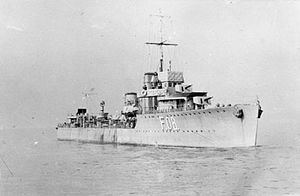Name HMS Vectis Completed 5 December 1917 | Ordered July 1916 Launched 4 September 1917 | |
 | ||
Fate Transferred for scrapping 25 August 1936 | ||
HMS Vectis (D51) was a V-class destroyer of the British Royal Navy that saw service in World War I and the Russian Civil War.
Contents
Construction and commissioning
Vectis, the first Royal Navy ship of the name, was ordered in July 1916. She was laid down by J. Samuel White at Cowes, Isle of Wight and launched on 4 September 1917. She was completed on 5 December 1917.
Service history
V- and W-class destroyers like Vectis were assigned to the Grand Fleet or Harwich Force for the rest of World War I.
In early June 1918, Vectis conducted towing trials with the NS-class airship N.S.3 to see if an airship which ran out of fuel or suffered a mechanical breakdown could be towed at speed by a ship at sea. Although initial trials were successful, with Vectis reaching nearly 20 knots with N.S.3 in tow, N.S.3 touched down on the sea on the final run.
After the armistice with Germany of 11 November 1918 brought World War I to an end, Vectis was incorporated into a new 3rd Destroyer Division, 2nd Destroyer Flotilla, in the spring of 1919. With the new formation, she took part during 1919 in the British campaign in the Baltic Sea against Bolshevik forces during the Russian Civil War.
Vectis was among the ships which accompanied the battlecruisers HMS Hood and HMS Tiger during their visit to Scandinavian ports in June 1920. During the voyage, she and the destroyer HMS Vega tested the Royal Navy's High Speed Mine Sweep, which the British Admiralty hoped to use in the shallow waters of the Baltic in the event of a war with Bolshevik Russia (soon to become the Soviet Union). In a blow to the Admiralty's plans, both destroyers lost their minesweeping apparatus, demonstrating the High Speed Mine Sweep to be impractical in shallow water.
In 1921, Vectis joined the light cruisers HMS Caledon, HMS Castor, HMS Cordelia, and HMS Curacoa and the destroyers HMS Vanquisher, HMS Venetia, HMS Viceroy, HMS Violent, HMS Viscount, HMS Winchelsea, and HMS Wolfhound in a Baltic cruise, departing the United Kingdom on 31 August 1921. The ships crossed the North Sea and transited the Kaiser Wilhelm Canal to enter the Baltic, where they called at Danzig in the Free City of Danzig; Memel in the Klaipėda Region; Liepāja, Latvia; Riga, Latvia; Tallinn, Estonia; Helsinki, Finland; Stockholm, Sweden; Copenhagen, Denmark; Gothenburg, Sweden; and Kristiania, Norway, before crossing the North Sea and ending the voyage at Port Edgar, Scotland, on 15 October 1921.
On 21 January 1925, Vectis took part with Royal Air Force bombers, the light cruisers Caledon, HMS Calliope, HMS Carysfort, and Curacoa, the battlecruisers Hood and HMS Repulse, and the battleships HMS Ramillies, HMS Resolution, HMS Revenge, HMS Royal Oak, and HMS Royal Sovereign in sinking the decommissioned battleship HMS Monarch as a target 50 nautical miles (93 km) south of the Scilly Isles, firing her 4-inch (102-mm) guns at Monarch.
Final disposition
After World War I, the United Kingdom received the passenger liner SS Bismarck from Germany in 1920 as a war reparation, and she was sold to the White Star Line, later the Cunard White Star Line, in which she served as RMS Majestic. In 1936, Cunard White Star retired Majestic and sold her to Thos W Ward for scrapping, but because of legal requirements imposed under the agreement transferring Majestic to the United Kingdom as a war prize, the British government instead took control of Majestic and assigned her to the Royal Navy. To pay Thos W Ward for Majestic, the Royal Navy agreed to transfer 24 old destroyers with a combined scrap value equivalent to that of Majestic to Thos W Ward for scrapping. Vectis was among these, and her transfer to Thos W Ward for scrapping took place on 25 August 1936. She was scrapped at Inverkeithing, Scotland.
